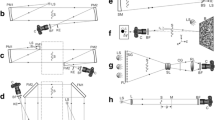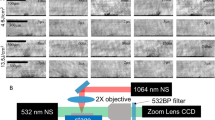Abstract
A numerical method for the inverse Abel transformation that can reconstruct plasma emissivity from a projected intensity profile is proposed. After calculating the derivatives of the projected intensity profile using a Volterra integral equation of the first kind, we approximate the derivative function in the Abel inversion transform using discrete least-squares approximation, and then, we obtain the emissivity profile using a numerical integral formula. It is shown that this process is numerically stable and efficient, and it is also resistant to noise when applied to experimental data, as demonstrated by our numerical results.







Similar content being viewed by others
Data Availability Statement
This manuscript has associated data in a data repository. [Authors’ comment: Data sets generated during the current study are available from the corresponding author on reasonable request.]
References
L.-B. Guo, D. Zhang, L.-X. Sun, S.-C. Yao, L. Zhang, Z.-Z. Wang, Q.-Q. Wang, H.-B. Ding, Y. Lu, Z.-Y. Hou, Z. Wang, Development in the application of laser-induced breakdown spectroscopy in recent years: A review. Front. Phys. (2021). https://doi.org/10.1007/s11467-020-1007-z
V.I. Babushok, F.C. DeLucia, J.L. Gottfried, C.A. Munson, A.W. Miziolek, Double pulse laser ablation and plasma: Laser induced breakdown spectroscopy signal enhancement. Spectrochim. Acta, Part B 61(9), 999–1014 (2006). https://doi.org/10.1016/j.sab.2006.09.003
N. Jedlinszki, G. Galbács, An evaluation of the analytical performance of collinear multi-pulse laser induced breakdown spectroscopy. Microchem. J. 97(2), 255–263 (2011). https://doi.org/10.1016/j.microc.2010.09.009
A.M. Popov, F. Colao, R. Fantoni, Enhancement of libs signal by spatially confining the laser-induced plasma. J. Anal. At. Spectrom. 24, 602–604 (2009). https://doi.org/10.1039/B818849A
Z. Hao, L. Guo, C. Li, M. Shen, X. Zou, X. Li, Y. Lu, X. Zeng, Sensitivity improvement in the detection of v and mn elements in steel using laser-induced breakdown spectroscopy with ring-magnet confinement. J. Anal. At. Spectrom. 29, 2309–2314 (2014). https://doi.org/10.1039/C4JA00144C
A. Nakimana, H. Tao, X. Gao, Z. Hao, J. Lin, Effects of ambient conditions on femtosecond laser-induced breakdown spectroscopy of al. J. Phys. D Appl. Phys. 46(28), 285204 (2013). https://doi.org/10.1088/0022-3727/46/28/285204
D.A. Rusak, T.P. Anthony, Z.T. Bell, Note: A novel technique for analysis of aqueous solutions by laser-induced breakdown spectroscopy. Rev. Sci. Instrum. 86(11), 116106 (2015). https://doi.org/10.1063/1.4935829
O.A. Nassef, H.E. Elsayed-Ali, Spark discharge assisted laser induced breakdown spectroscopy. Spectrochim. Acta, Part B 60(12), 1564–1572 (2005). https://doi.org/10.1016/j.sab.2005.10.010
H. Yuan, W. Ke, J.Q. Liu, M.Y. Chen, X.H. Wang, A.J. Yang, J.F. Chu, D.X. Liu, M.Z. Rong, Radial characteristics of laser-induced plasma under the influence of air pressure. J. Phys. D Appl. Phys. (2023). https://doi.org/10.1088/1361-6463/ace197
Y. Huang, S.S. Harilal, A. Bais, A.E. Hussein, Progress toward machine learning methodologies for laser-induced breakdown spectroscopy with an emphasis on soil analysis. IEEE Trans. Plasma Sci. (2023). https://doi.org/10.1109/TPS.2022.3231985
E. Kepes, J. Vrabel, T. Brazdil, P. Holub, P. Porizka, J. Kaiser, Interpreting convolutional neural network classifiers applied to laser-induced breakdown optical emission spectra. TALANTA (2024). https://doi.org/10.1016/j.talanta.2023.124946
R. Noll, H. Bette, A. Brysch, M. Kraushaar, I. Mönch, L. Peter, V. Sturm, Laser-induced breakdown spectrometry - applications for production control and quality assurance in the steel industry. Spectrochimica Acta Part B Atomic Spectrosc. 56(6), 637–649 (2001). https://doi.org/10.1016/S0584-8547(01)00214-2
J. Moros, J. Laserna, Laser-induced breakdown spectroscopy (libs) of organic compounds: A review. Appl. Spectrosc. 73(9), 963–1011 (2019)
P.S. Hsu, M. Gragston, Y. Wu, Z. Zhang, A.K. Patnaik, J. Kiefer, S. Roy, J.R. Gord, Sensitivity, stability, and precision of quantitative ns-libs-based fuel-air-ratio measurements for methane-air flames at 1–11 bar. Appl. Opt. 55(28), 8042–8048 (2016). https://doi.org/10.1364/AO.55.008042
Y. Dixit, M.P. Casado-Gavalda, R. Cama-Moncunill, X. Cama-Moncunill, M. Markiewicz-Keszycka, P.J. Cullen, C. Sullivan, Laser induced breakdown spectroscopy for quantification of sodium and potassium in minced beef: a potential technique for detecting beef kidney adulteration. Anal. Methods 9, 3314–3322 (2017). https://doi.org/10.1039/C7AY00757D
H.K. Sanghapi, K.K. Ayyalasomayajula, F.Y. Yueh, J.P. Singh, D.L. McIntyre, J.C. Jain, J. Nakano, Analysis of slags using laser-induced breakdown spectroscopy. Spectrochim. Acta, Part B 115, 40–45 (2016). https://doi.org/10.1016/j.sab.2015.10.009
P. Mishra, R. Kumar, A.K. Rai, Development and optimization of experimental parameters for the detection of trace of heavy metal (cr) in liquid samples using laser-induced breakdown spectroscopy technique. J. Laser Appl. 35(2), 022021 (2023). https://doi.org/10.2351/7.0000959
X. Yang, R. Yi, X. Li, Z. Cui, Y. Lu, Z. Hao, J. Huang, Z. Zhou, G. Yao, W. Huang, Spreading a water droplet through filter paper on the metal substrate for surface-enhanced laser-induced breakdown spectroscopy. Opt. Express 26(23), 30456–30465 (2018). https://doi.org/10.1364/OE.26.030456
Y. Qu, Q. Zhang, W. Yin, Y. Hu, Y. Liu, Real-time in situ detection of the local air pollution with laser-induced breakdown spectroscopy. Opt. Express 27(12), 790–799 (2019). https://doi.org/10.1364/OE.27.00A790
N. Hausmann, H.K. Robson, C. Hunt, Annual growth patterns and interspecimen variability in mg/ca records of archaeological ostrea edulis (european oyster) from the late mesolithic site of conors island. Open Quat. 5(1), 9 (2019). https://doi.org/10.5334/oq.59
D. Woodbury, R.M. Schwartz, H.M. Milchberg, Measurement of ultralow radiation-induced charge densities using picosecond mid-ir laser-induced breakdown. Optica 6(6), 811–820 (2019). https://doi.org/10.1364/OPTICA.6.000811
N. Killiny, E. Etxeberria, A.P. Flores, P.G. Blanco, T.F. Reyes, L.P. Cabrera, Laser-induced breakdown spectroscopy (LIBS) as a novel technique for detecting bacterial infection in insects. Sci. Rep. (2019). https://doi.org/10.1038/s41598-019-39164-8
L. Ghervase, I.M. Cortea, Lighting up the heritage sciences: The past and future of laser-induced fluorescence spectroscopy in the field of cultural goods. Chemosensors (2023). https://doi.org/10.3390/chemosensors11020100
C. Wang, M. Fomovsky, G. Miao, M. Zyablitskaya, S. Vukelic, Femtosecond laser crosslinking of the cornea for non-invasive vision correction. Nat. Photon. 12(7), 416–422 (2018). https://doi.org/10.1038/s41566-018-0174-8
S. Mittelmann, K. Touchet, X. Mao, M. Park, S. Brezinsek, G. Pretzler, V. Zorba, Hydrogen isotope analysis in w-tiles using fs-libs. Sci. Rep. 13, 2285 (2023)
J. Ding, T. Zhang, H. Li, Recent advances in laser-induced breakdown spectroscopy for explosive analysis. Trac-trends Anal. Chem. (2023). https://doi.org/10.1016/j.trac.2023.117197
L.J. Radziemski, T.R. Loree, D.A. Cremers, N.M. Hoffman, Time-resolved laser-induced breakdown spectrometry of aerosols. Anal. Chem. 55(8), 1246–1252 (1983). https://doi.org/10.1021/ac00259a016
M. Sabsabi, P. Cielo, Quantitative analysis of aluminum alloys by laser-induced breakdown spectroscopy and plasma characterization. Appl. Spectrosc. 49(4), 499–507 (1995). https://doi.org/10.1366/0003702953964408
F.G. Tricomi, Integral Equations (Dover Publications, New York, 1985)
M. Hanke, O. Scherzer, Inverse problems light: Numerical differentiation. Am. Math. Mon. 108(6), 512–521 (2001). https://doi.org/10.1080/00029890.2001.11919778
Z. Zhao, Z. Meng, G. He, A new approach to numerical differentiation. J. Comput. Appl. Math. 232(2), 227–239 (2009). https://doi.org/10.1016/j.cam.2009.06.001
M. Deutsch, I. Beniaminy, Derivative-free inversion of abel’s integral equation. Appl. Phys. Lett. 41(1), 27–28 (1982). https://doi.org/10.1063/1.93309
S. Gueron, M. Deutsch, A fast abel inversion algorithm. J. Appl. Phys. 75(9), 4313–4318 (1994). https://doi.org/10.1063/1.355973
M. Deutsch, I. Beniaminy, Inversion of abel’s integral equation for experimental data. J. Appl. Phys. 54(1), 137–143 (1983). https://doi.org/10.1063/1.331739
H. Edels, K. Hearne, A. Young, Numerical solutions of the abel integral equation. J. Math. Phys. (1962). https://doi.org/10.1002/sapm196241162
M.P. Freeman, S. Katz, Determination of the radial distribution of brightness in a cylindrical luminous medium with self-absorption. J. Opt. Soc. Am. 50(8), 826–830 (1960). https://doi.org/10.1364/JOSA.50.000826
C.J. Cremers, R.C. Birkebak, Application of the abel integral equation to spectrographic data. Appl. Opt. 5(6), 1057–1064 (1966). https://doi.org/10.1364/AO.5.001057
V. Dribinski, A. Ossadtchi, V.A. Mandelshtam, H. Reisler, Reconstruction of abel-transformable images: The gaussian basis-set expansion abel transform method. Rev. Sci. Instrum. 73(7), 2634–2642 (2002). https://doi.org/10.1063/1.1482156
G. Minerbo, M. Levy, Inversion of abel’s integral equation by means of orthogonal polynomials. SIAM J. Numer. Anal. 6(4), 598–616 (1969). https://doi.org/10.1137/0706055
E.L. Kosarev, Spatial distribution of flare stars in the Pleiades derived by the orthogonal expansion method. Peremennye Zvezdy 21, 321–363 (1980)
S. Ma, H. Gao, G. Zhang, L. Wu, Abel inversion using legendre wavelets expansion. J. Quant. Spectrosc. Radiat. Transfer 107(1), 61–71 (2007). https://doi.org/10.1016/j.jqsrt.2007.01.054
H. Ruan, B. Wan, A new method for asymmetrical abel inversion using fourier-bessel expansions. Int. J. Infrared Millimeter Waves 21(12), 1973–1987 (2000). https://doi.org/10.1023/A:1006724218429
N. Gottardi, Evaluation of electron density profiles in plasmas from integrated measurements. J. Appl. Phys. 50(4), 2647–2651 (1979). https://doi.org/10.1063/1.326221
J.H. Ha, Y.U. Nam, M.S. Cheon, Y.S. Hwang, An improved abel inversion method modified for tangential interferometry in tokamak. Rev. Sci. Instrum. 75(10), 3408–3410 (2004). https://doi.org/10.1063/1.1788891
M. Deutsch, Abel inversion with a simple analytic representation for experimental data. Appl. Phys. Lett. 42(3), 237–239 (1983). https://doi.org/10.1063/1.93892
X.-F. Li, L. Huang, Y. Huang, A new abel inversion by means of the integrals of an input function with noise. J. Phys. A: Math. Theor. 40(2), 347–360 (2006). https://doi.org/10.1088/1751-8113/40/2/012
K. Sadri, A. Amini, C. Cheng, A new operational method to solve abel’s and generalized abel’s integral equations. Appl. Math. Comput. 317, 49–67 (2018). https://doi.org/10.1016/j.amc.2017.08.060
R.K. Pandey, S. Suman, K.K. Singh, O.P. Singh, An approximate method for abel inversion using chebyshev polynomials. Appl. Math. Comput. 237, 120–132 (2014). https://doi.org/10.1016/j.amc.2014.03.043
P.A. Vicharelli, W.P. Lapatovich, Iterative method for computing the inverse abel transform. Appl. Phys. Lett. 50(10), 557–559 (1987). https://doi.org/10.1063/1.98133
S.A. Yousefi, Numerical solution of abel’s integral equation by using legendre wavelets. Appl. Math. Comput. 175(1), 574–580 (2006). https://doi.org/10.1016/j.amc.2005.07.032
O.P. Singh, V.K. Singh, R.K. Pandey, A stable numerical inversion of abel’s integral equation using almost bernstein operational matrix. J. Quant. Spectrosc. Radiat. Transfer 111(1), 245–252 (2010). https://doi.org/10.1016/j.jqsrt.2009.07.007
V. Singh, R. Pandey, O. Singh, New stable numerical solutions of singular integral equations of abel type by using normalized bernstein polynomials. Appl. Math. Sci. 3(5–8), 241–255 (2009)
L. Huang, Y. Huang, X.-F. Li, Approximate solution of abel integral equation. Comput. Math. Appl. 56(7), 1748–1757 (2008). https://doi.org/10.1016/j.camwa.2008.04.003
J. Wu, Y. Zhou, C. Hang, A singularity free and derivative free approach for abel integral equation in analyzing the laser-induced breakdown spectroscopy. Spectrochimica Acta Part B Atomic Spectrosc. (2020). https://doi.org/10.1016/j.sab.2020.105791
Funding
This work is supported by National Science Foundation of China (NSFC) Grant No. 11804396. XH is supported by Marie Curie Fellowship HADG-101027463 agreed between QMUL and the European Commission.
Author information
Authors and Affiliations
Corresponding author
Rights and permissions
Springer Nature or its licensor (e.g. a society or other partner) holds exclusive rights to this article under a publishing agreement with the author(s) or other rightsholder(s); author self-archiving of the accepted manuscript version of this article is solely governed by the terms of such publishing agreement and applicable law.
About this article
Cite this article
Wu, J., Luo, W., Song, W.G. et al. A laser-induced plasma analysis based on the inversion of Abel transformation. Eur. Phys. J. Plus 139, 89 (2024). https://doi.org/10.1140/epjp/s13360-024-04866-0
Received:
Accepted:
Published:
DOI: https://doi.org/10.1140/epjp/s13360-024-04866-0




